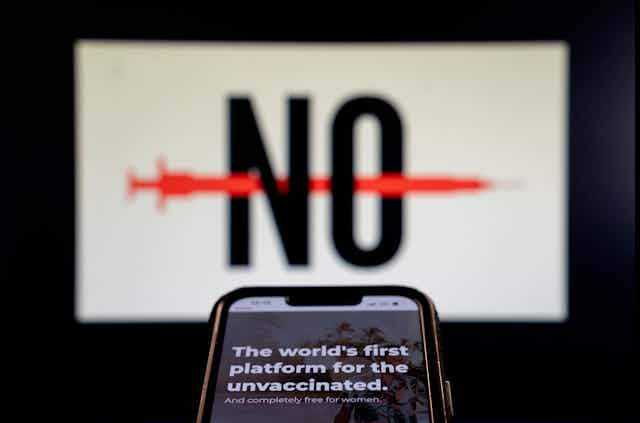If you think memes are simply online images of cute cats and celebrities with funny captions, then you might be surprised to learn that they can have a more sinister function.
Our research shows that memes form part of a highly sophisticated strategy to spread and monetise health disinformation.
Memes may appear trivial, but they should be taken seriously. Dismissing them as harmless jokes is to grossly underestimate their influence – and bolsters their power to spread potentially harmful health messages.
Anti-vaccine memes have a long history
Memes aren’t a recent invention. They have featured prominently in anti-vaccination messaging for centuries.

When widespread smallpox immunisation began in the early 19th century, political cartoons published in print media used memes (see image below) to evoke fear about the safety of the vaccine.

The most infamous anti-vaccination meme, however, emerged from a now discredited 1998 study that falsely linked the measles, mumps and rubella (MMR) vaccine with autism.
The meme “vaccines cause autism”, which appeared on billboards and was circulated widely in the media, provoked doubts about the safety of the vaccine. The study, since described as an “elaborate fraud”, was published the same year as the launch of Google’s search engine allowing “vaccines cause autism” to became a global meme.
Today, memes remain an important part of the anti-vaccine movement. The internet enables memes to be created anonymously, repurposed and shared at scale – making them a highly effective medium for spreading health disinformation.
They are often used as part of a meme war, defined as “the intentional propagation of political memes on social media for the purpose of political persuasion or community building, or to strategically spread narratives and other messaging crucial to a media manipulation campaign.” According to disinformation research platform The Media Manipulation Casebook.
Memes play an integral role in disinformation campaigns by facilitating fear, uncertainty and doubt.
Influencers and money
Our study analysed how popular anti-vaccine influencers used memes to galvanise the anti-vaccine movement during the COVID pandemic.
We discovered three recurring themes for encouraging vaccine refusal.
First, memes were used to vilify the government and social institutions, portraying them as corrupt and politically compromised. Anti-government sentiments were used to support several claims. These included claims that the government is corrupt and tyrannical; that vaccines are unsafe and ineffective and that the government is using vaccines as a form of state surveillance, for control and profit.
Second, memes depicted unvaccinated people as unfairly stigmatised. Influencers suggested the unvaccinated were being persecuted, using evocative imagery to imply a false equivalence between those who remain unvaccinated by choice and the persecution of Jews during the Holocaust. Such memes portrayed unvaccinated people as victims subject to Nazi-like sanctions and social exclusion.

Third, vaccinated people were depicted as morally and physically inferior to the unvaccinated. Vaccination was associated with infertility, low sex drive and a lack of critical thinking. Those opposed to vaccines, however, were portrayed positively as virile, attractive and intellectually superior.
To establish group membership and promote a sense of belonging, influencers referred to those who are anti vaccines as their “soul family”. But our research suggests there may be a more cynical motivation behind this apparently warm sentiment.
Going viral – and avoiding challenge
Influencers were strategic in their use of memes for political persuasion and commercial gain.
Several influencers provided their followers with “meme drops”: packages of memes with dissemination instructions. These memes were tested and produced in meme factories, then distributed monthly to a mass audience via personal newsletters and websites, encouraging followers to spread anti-vaccination content. By adapting memes to current affairs, influencers increased their relevance and likelihood of going viral.
Memes weren’t just a method of self-promotion for anti-vaccination influencers, however. They were also a way to profit financially from pandemic anxieties.
Anti-vaccine sentiment became a powerful gateway to promote potentially harmful health products. We found that memes were used to market unauthorised medical products by directing consumers to online stores. For example, we found that clicking on satirical COVID themed memes directed consumers to purchase hydroxychloroquine (a treatment for autoimmune disorders) and veterinary Ivermectin (used to treat parasites in animals). Both medicines are unapproved for the treatment of COVID.


Memes are powerful propagators of disinformation because they allow influencers to claim plausible deniability. Under the protective guise of humour and satire, memes can evade fact checkers and content moderators while promoting anti-vaccine myths and unauthorised treatments.
Influencers promoting vaccine hesitancy use memes to build their online following, sow distrust of health authorities and profit from the promotion of unapproved medicines. This enables them to evade responsibility for any negative consequences of their messaging.
Memes may not look threatening – but that’s why they are such effective super spreaders of health disinformation.

